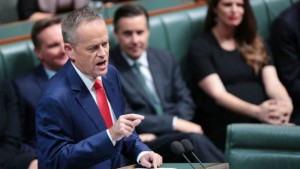Home » Commentary » Opinion » Bill Shorten keeps tax system in a state of half-pregnancy
· The Australian Financial Review
 Labor’s long-running fairness-and-equality show needs to be continually refreshed with new acts, and its just raised the curtain on the latest one.
Labor’s long-running fairness-and-equality show needs to be continually refreshed with new acts, and its just raised the curtain on the latest one.
Labor’s failure to stop the Coalition’s six-year personal income tax plan from entering the statute books seems to have only emboldened opposition to the government’s 10-year enterprise tax plan.
Under that plan, next week the company tax rate for all companies with turnover up to $50 million will be cut from 30 per cent to 27.5 per cent. Bill Shorten – apparently after consulting himself – this week pledged to reverse the cut for all companies down to a turnover of $10 million, and says he will consider reversing it all the way down to $2 million.
This takes the chutzpah of Labor’s tax policy to a new level as it strives to maximise its differentiation from Coalition policy.
Reversing a tax cut that hasn’t yet taken effect is one thing; reversing one that is already benefiting more than 100,000 businesses (or creating uncertainty about its retention) is quite another. It becomes a tax increase. The opposition are displaying a high degree of confidence they are onto a winner in opposing tax cuts – or better still, proposing tax increases – for companies and any individuals that can be labelled ‘well off’.
The revenue to be gained by peeling the threshold back from $50 million to $10 million – although non-trivial – is not the key attraction. Rather, it is the symbolic value of reversing a tax cut for businesses other than the very smallest.
The Australian company tax system is in a state of half-pregnancy between a 30 per cent rate and a 25 per cent rate. It makes no sense for it to stay there. Even the Whitlam government understood that a progressive company tax scale was a nonsense and ditched it in 1974.
Company size is not an indicator of profitability – and even if it were, companies are not people. If equity demands progressive taxation, that principle is best applied at the personal level, not at the corporate one.
In Australia, the two-tier structure made a comeback in 2015 when the rate was lowered to 28.5 per cent for companies with turnover up to $2 million. The Turnbull government has continued along this path, but doing so only makes sense as a transition to the endpoint – 25 per cent for all companies. A permanent two-tier system would be worse than keeping the rate at 30 per cent for all companies.
The fact Shorten intends keeping the lower rate at least for companies with turnover up to $2 million – thereby keeping the system in permanent half-pregnancy – shows that he is not deaf to the siren-song of small business. But all a two-tier system does is create a distortion and an incentive for companies to stay just below the threshold. Any benefit to investment would be small.
Indeed, there is more investment bang for the buck from cutting company tax for large businesses. Australia’s dividend imputation system – which gives shareholders a full credit for company tax paid on dividends, but charges them full personal tax on those dividends – means the company tax rate is irrelevant to the tax resident shareholders pay on dividends. That argument changes when foreign investors (which do not benefit from imputation) are brought into the picture, but foreign investors generally do not play on the small business field.
For this reason, cutting the company tax rate is less beneficial for small businesses than for large companies, where foreign investors are major players. In fact, if we must have a two-tier company tax system and live with the distortions it entails, a lower rate for the larger-company sector would be of greater economic benefit.
But the benefits of a lower tax rate for all companies – free of the distortions of a two-tier system – dominate all other options. The government’s key spokespeople need to get on with the job of explaining why this choice best serves both economic efficiency and fairness, if they are to attract the audience away from the fairness-and-equality sideshow.
In doing so, they must be careful not to overstate the link from a company tax cut to wage increases. While it is true that workers bear much of the final incidence of company tax, the reasons are complex. The link works through a lower after-tax rate of return, higher investment and higher productivity. We hear too little of this story from advocates of the company tax cut and too much that suggests company tax savings will just flow directly into wages.
Robert Carling is a senior fellow at The Centre for Independent Studies and a former federal and state Treasury and IMF official.
Bill Shorten keeps tax system in a state of half-pregnancy